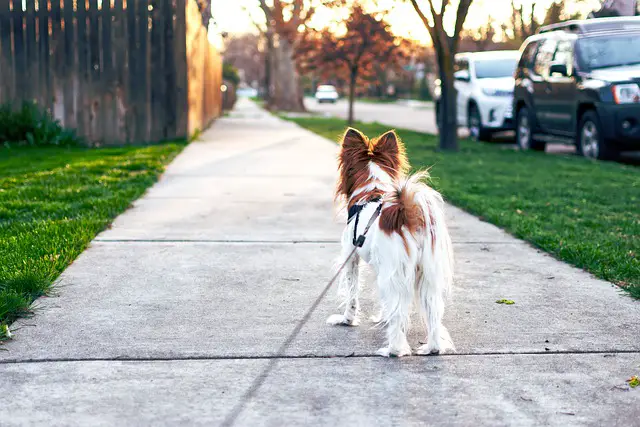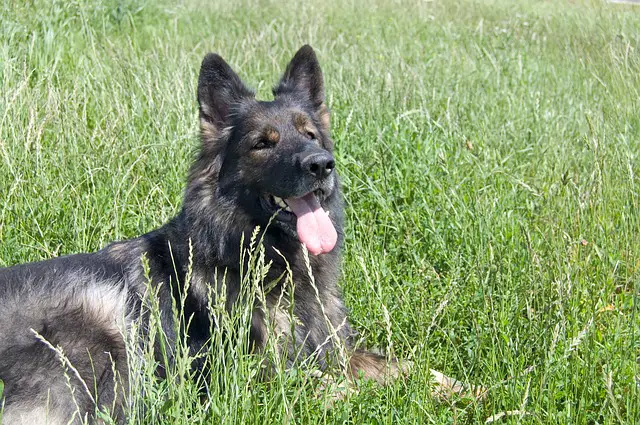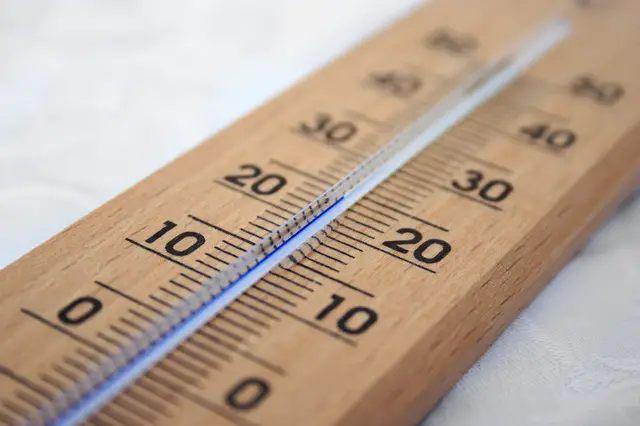
Overheating in dogs is a huge deal. So, your attempt to find out when it is too hot to walk your dog is not overthinking. It’s perfectly good thinking and can even save you from big trouble including heatstroke in dogs.
So, if you’re currently experiencing a heatwave, as much as exercising your dog is important, you might want to reconsider your schedule so that something that was intended for good does not become the opposite.
As we go into why walking your dog in the heat is a terrible idea, here are some facts to chew on.
We know for a fact that when it’s 77 degrees outside (Fahrenheit, of course), the pavement can heat up to 125 degrees. A ten-degree increase in this atmospheric temperature can cause the pavement to further heat up to a scalding 143 degrees.
Alright, let’s make this more relatable. At 135 degrees, 8 degrees cooler than 143, asphalt can fry an egg in 5 minutes. Yep, 5 minutes. Think of what that would do to your dog’s paws.
And it isn’t just his paws. Most animals are lower to the ground than humans which means that they are closer to this scalding temperature from the ground than humans. So, they overheat faster and overheating is something you want to avoid like a plague with your dog.
Table of Contents
Why Walking Your Dog In The Summer Heat Is So Dangerous
1. Burns Your Dogs Paws
Many don’t realize this but the bottom of your dog’s paws is not the same as the bottom of a horse’s. Dogs have actual skin on the pads of their paws. Yes, this skin is tougher than most and can endure quite a number of things. Nonetheless, this fleshy part of the paws can get damaged if exposed to too high temperatures.
2. High Humidity Makes It Harder To Cool Off Naturally

But it isn’t just hot pavements and asphalt that constitute a problem. Besides the unbearable heat, summer also brings with it, the unbearably high humidity.
Now, naturally, dogs cool off by panting. This helps them remove excess moisture through their lungs which, in turn, pushes the heat from inside their body out.
If the humidity gets too high, however, this natural process experiences a small hindrance and dogs are no longer able to cool off naturally. When this happens, of course, you know what’s inevitable. Body temperature begins to shoot up since the heat is trapped in the body and there’s no way to expel it.
While this is a pretty scary scenario, it’s really not as bad for all dogs. Smaller breeds, for instance, have a much reduced risk of running into overheating problems.
Large breeds, on the other hand, especially those with flat faces like pugs, mastiffs, and bull dogs are at a much higher risk. Already most of them suffer breathing problems. Extremely high temperatures will only serve to make things a whole lot worse. In fact, if the temperature increases beyond 104 degrees Fahrenheit at a time, it could prove fatal for some of these dogs.
3. Heatstroke
Finally, we have the almighty heatstroke. It’s scary how swiftly things escalate when dogs come down with heatstroke. Vets in emergency vets recount with a breaking heart how many dogs they treat for heatstroke yearly and how many of these stories end up tragically.
From what we know, most cases of reported heatstroke cases in dogs are as a result of their owners walking them in the hottest part of the day. Precisely, that would be between 8 am and 8 pm.
Generally, heat-related illnesses, such as heatstroke in dogs, are preventable. Also, if you notice signs such as redness of the eyes and gums, hot skin, vomiting, collapse, or reduced activity, then your dog might be suffering a heatstroke and you need to contact your vet or emergency vet clinic (if after hours) immediately.
Hopefully, there’s something that can be done for your dog when you get there. Because the truth is that, if symptoms are already showing, then considerable damage has most likely already been done. In many cases, the victim does not survive it as all that is required is 15 minutes for heatstroke to become fatal in dogs. So, please never risk it.
When Is It Too Hot To Walk Your Dog? – A Helpful Guide

53 – 59 Degrees Fahrenheit (12 – 15 Degrees Celsius)
At these temperatures, your dog is safe and you can enjoy your walk happily. There’s no risk of heatstroke.
60 – 63 Degrees Fahrenheit (16 – 19 Degrees Celsius)
This temperature range is still considered relatively cool for all involved. You can walk your dog and exercise him all day. However, if you have a large breed, an obese dog, or a flat-faced dog, then keep an eye on him for any sign of exhaustion.
68 – 74 Degrees Fahrenheit (20 – 23 Degrees Celsius)
While this temperature range is still considered quite cool, certain dogs have a risk of suffering a heatstroke if exercised too rigorously. Dogs in this category include obese dogs as well as those with breathing problems.
24 – 27 Degrees Celsius (75 – 81 Degrees Fahrenheit)
Again, the risk of a heatstroke increases significantly. Please, be extremely careful at this point. Especially if your dog is a large breed, obese, very young, or flat-faced, he is going to find such temperatures extremely uncomfortable.
28 – 31 Degrees Fahrenheit (82 – 88 Degrees Celsius)
At this point, every dog is at risk of a heatstroke regardless of their breed, age, or health condition. However, obese, flat-faced, large breeds, and puppies are even at higher risks. In fact, such temperatures are life-threatening for them.
32 Degrees Celsius And Over (89 Degrees Fahrenheit And Over)
Every dog is at risk of a heatstroke regardless of health status, breed, size, and age.
Tips And Tricks To Help Decide When It Is Too Hot To Walk Your Dog

A most common tip for determining when it is too hot to walk your dog is to feel the pavement yourself. Depending on whom you’re listening to, there are a number of ways to do this.
First, put your palm on the pavement and wait for seven seconds (some say 5). If the pavement feels too hot to your palm, then it’s going to be too hot for your dog’s paws.
Secondly, you can stand barefoot on the pavement for some seconds yourself. If it feels too hot, then it would definitely be too hot for your dog’s paws as well.
Now, keep in mind that if you have a puppy, puppy paw pads are less tolerant of heat than those of adult dogs. Even temperatures that you can tolerate on your bare palm or feet might still be too hot for them. So, you also want to put that into consideration.
Generally, you want to avoid walking your dog within the hours of 8 am and 8 pm as this tends to be the hottest part of the day when it is, generally, too hot to walk your dog. Even when walking during those hours, try to keep to the shade too.
Furthermore, observe your dog. If he’s already beginning to pant in just a few minutes after you started your walk, that’s a sign that it’s too warm. It’s time for y’all to head on home.
Watch this man demonstrate the 5-second rule for testing when it is too hot to walk your dog.
Symptoms Your Dog Is Overheating
So, say you’re walking or you’re home, this video shows how you can tell your dog is overheating.
According to an article on Mercola Pets, here are signs that your dog is overheating.
- He’s panting heavily.
- Thirst for water is excessive.
- Eyes look glazed.
- He begins to vomit or have bloody diarrhea.
- Gums and tongue are a bright or dark red.
- Becomes weak and even collapses.
- Pulse and heartbeat increase.
- He develops a seizure.
- Drooling becomes excessive.
- He becomes unconscious.
Heatstroke is so dangerous and occurs once your dog’s body temperature gets to 109 degrees Fahrenheit (or 42 degrees celsius). Once this happens, cells are dying rapidly. The brain is swelling which causes the seizures. Blood supply to the gut is cut off so ulcers result. Then dehydration causes irreversible damage to the kidney. All these seem like a lot but they actually occur in minutes.
Dogs At Higher Risks Of Overheating

1. Dogs with short noses and flat faces known as brachycephalic dogs. Because these dogs have shorter noses than other dogs, they typically tend to have breathing difficulties, and, therefore, can’t pant as efficiently as other breeds with their longer noses.
Examples of such dogs include Pugs, Pekinese, Boston Terriers, Bulldogs, Boxers, and Shi Tzus.
- Senior dogs.
- Puppies.
- Dogs that are sick as well as those with grave health conditions such as heart diseases.
- Dogs that are not acclimated to hot weather.
- Any dog, healthy or not, left outside in the summer heat.
- Dogs that are overexerted in the heat.
What To Do If You Think Your Dog Is Overheating

- Move the dog to a cool area that’s shaded or, more preferably, air-conditioned.
- Assess the situation. If he’s conscious, able to stand, and able to pant, give him some water to drink and then take his temperature.
- If the temperature hasn’t exceeded 104 degrees Fahrenheit, then keep observing him and keep give him water, a little at a time. Too much at a time and he might vomit which could increase his risk of dehydration.
- Once he is comfortable, contact your vet.
- If your pet can’t stand, isn’t responding, or appears to be having a seizure, check for a heartbeat and check for breathing while getting someone to call the vet and let them know you’re on the way. If you’re alone, you’d have to do that yourself.
Bottom line is, you want the clinic to be aware that you’re coming so they can prepare to treat your pet.
- Cool him down by hosing him down with cool (not cold) water. You can also use some wet towels or any other available cooling source. If you can, take his temperature.
- You want to concentrate cooling especially around the head, neck, as well as underneath his front and hind limbs.
- Carefully cool the tongue if you can but don’t pour water down his throat if he can’t swallow by himself.
- You can turn on a fan on him to speed up the cooling process as well.
- Check his temperature at intervals and stop cooling once its at 104 degrees Fahrenheit. If you keep cooling, his temperature could drop dangerously low and blood clotting could also result.
- Take your dog to the vet even if it seems he’s recovering.
How To Keep Your Dog From Overheating In The Summer
- Dogs tend to overheat quickly, especially in the summer. So, make sure your dog has access to enough water, fresh and clean, at all times. If he’s going to be outdoors for any duration of time, then make sure the area is shaded.
Consider adding some ice cubes as well to make the water cooler for your dog. Iced treats are also not a bad idea, whether it’s iced beef stock, or dog-friendly ice cream or yogurt, stock up on these treats as you go into the summer.
- You might also want to groom your dog in preps for the summer. You can shave your long-coated dog to about an inch in length but no shorter. While long furs contribute to overheating, they also help to protect your dog from the sun. So, you don’t want them too short. (Click here to understand more about dog grooming).
If you don’t like the idea of shaving your dog, then be ready to give your dog baths regularly to help him combat the heat.
- Only walk your pup in the coolest parts of the day before 8 am and after 8 pm. Always stay in the shade, and if it’s hotter than 85 degrees, your dog should be indoors. If he must be outdoors, then play with the sprinkler or hose him down but he must be in the shade.
- Do not over-exercise or overexert your dog whatever time of day.
- No walking on hot pavement. We’ve shown you how to test for hotness. It not only burns your dog’s paws, but because your pet is lower to the ground than you, the tendency to overheat quickly is higher with him.
(There are summer dog shoes that dogs can wear while going for walks in the summer. Click here to read our article on dog footwear. Please note that dog footwear or not, all the rules about walking in the summer on hot pavement must still be followed).
- Of course, you never leave your pet in your car alone. Keep him in a cool area and make sure he’s hydrated.
- You can also take your dog swimming as well. Just ensure that he likes to swim, and let the swimming take place in a pool, preferably, not the beach. (Click here to read our article on dog life jackets).
In this video, Instructor Steve shares further tips to keep your dog cool and comfortable in the summer heat.